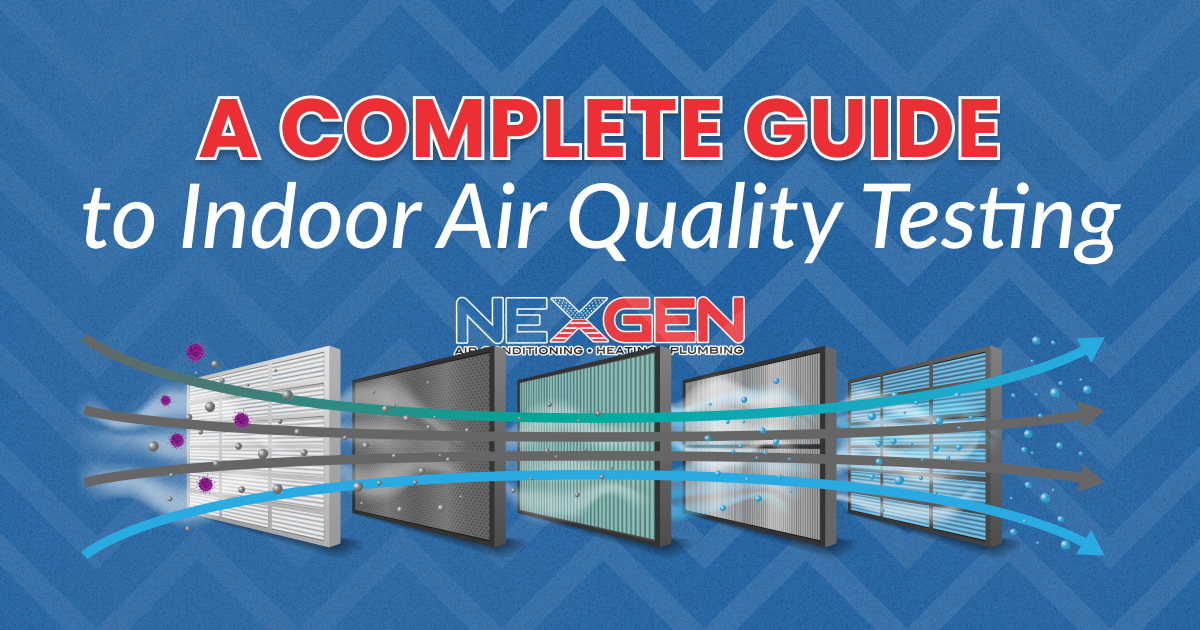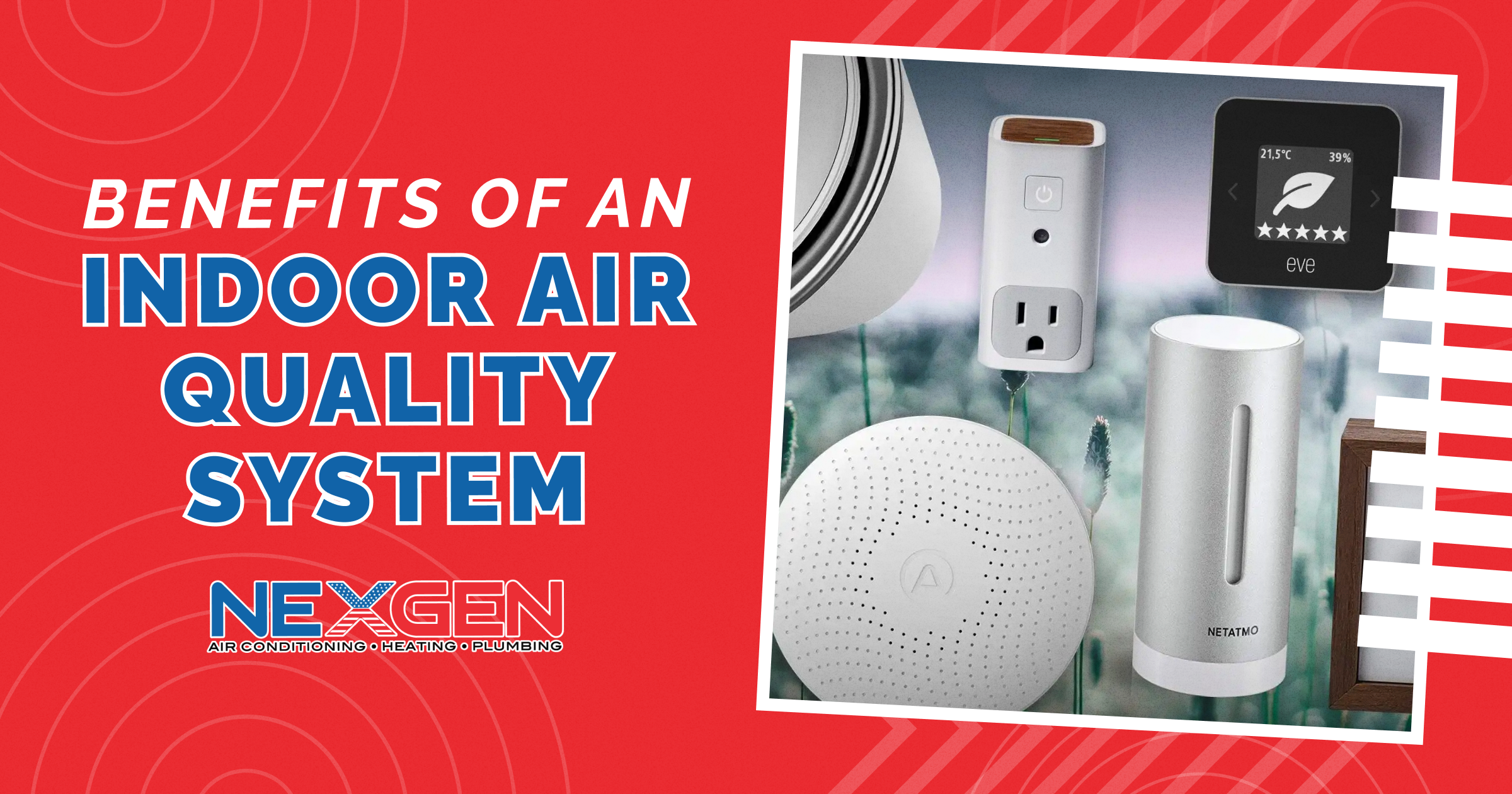A Complete Guide to Indoor Air Quality Testing

In this guide to indoor air quality testing, we’ll look at the different contaminants that may be in the air you breathe and how to find them. These can include dust, pollen, mold, particulates, and volatile organic compounds (VOCs). Poor indoor air quality (IAQ) can affect your comfort and health, but knowing what’s polluting your home can help find solutions. Here’s a closer look at indoor air quality testing and the options available.
Know the Signs of Poor Indoor Air Quality
There are far too many pollutants to test for all at once. But various indicators can point to certain IAQ issues, so start by recognizing these signs of a potential issue:
- Health Symptoms: Coughing, congestion, and other respiratory symptoms are the most common issues associated with polluted air. Eye, nose, and throat irritation can also point to a problem. Other signs of bad IAQ include headache, dizziness, nausea, confusion, and fatigue.
- Poor Ventilation: If there’s reduced airflow from HVAC vents or your home seems stuffy, check for musty odors that can indicate mold is growing or for condensation on walls or windows.
- Aging Home: Older homes often contain materials that can emit VOCs and have persistent ventilation issues. They may have also been constructed before modern building codes were introduced.
Schedule professional IAQ testing if any of these issues are familiar to you.
Types of Testing
Aside from what to test for (which we’ll discuss soon), there are different types of IAQ testing to consider. Some methods can check for several pollutants; others are intended to check for a specific contaminant. These are the most common methods used:
- Ambient Air Quality Testing: Measures the types and levels of pollutants outside your home to identify potential sources of pollution.
- Indoor Air Quality Testing: The level of pollution inside your home or office is measured along with the risk of exposure to harmful substances.
- Particulate Matter Testing: This can determine the concentrations of dust, smoke, and other minute particles and help find ways to address the problem.
If there are pollution sources near your home contributing to IAQ concerns, source testing or stack emission testing can be performed at specific locations, such as industrial facilities. Mobile source testing measures pollution from vehicles and other modes of transportation. These methods can help find ways to reduce the risks and amount of pollution in your home.
IAQ Monitors
An indoor air quality monitor is a simple and inexpensive way to determine if your home has any IAQ problems. Depending on the model, it can measure temperature and humidity or toxins in the air (via electrochemical sensors). Some units can estimate the level of particulate matter using a laser or volatile organic compounds from building materials such as carpeting. An IAQ monitor may determine the Air Quality Index (AQI), a measurement devised by the U.S. Environmental Protection Agency (EPA) to determine the health risks of outdoor and indoor pollution.
Carbon Monoxide Detectors
Carbon monoxide (CO) is odorless and colorless but can cause sickness and death. It has many sources, including malfunctioning heating systems. Required near bedrooms and on every floor of your home, a CO detector should be placed wherever there’s a smoke detector (some units combine both functions) about 5 feet above the floor or near the ceiling.
Mold Testing Kits
Various types of mold tests are available. Swabs and tape strips allow you to collect samples from surfaces. Some swab tests yield results in minutes, although they won’t reveal the type of mold. Tape strips and petri dish tests must be analyzed in a lab. Nonetheless, contamination by other particles can skew the results. An air pump test is closed off and less likely to be contaminated.
For the most accurate mold testing, hire a professional if you think your home is infested.
Radon Testers
Found naturally in soil and rocks, radon gas can seep through tiny cracks in your home’s foundation. High levels can have long-term health effects, including cancer. But radon testing takes time. Depending on the test, it can take 90 days to several months, and even then, a lab must interpret the results. You can also install a continuous radon monitor that will alert you if levels get too high.
Know What Is Polluting Your Home
Indoor air quality testing can identify pollutants such as pollen, mold, or dust. Tobacco smoke and fuel combustion sources can severely reduce IAQ. But there may be many pollution sources you don’t know about. For example, aerosol sprays, paints, pesticides, disinfectants, scented candles, dry cleaning, and manufactured furniture can contain harmful compounds and contribute to pollution inside your home.
Hire an Indoor Air Quality Testing Professional
At NexGen, our licensed professionals can test for VOCs, mold, carbon monoxide, and other contaminants. We are Google Certified for Home Services. Our team can identify and address IAQ issues in your home or business. For fast and accurate indoor air quality testing and proven solutions, call (805) 301-6788 today.
Benefits of an Indoor Air Quality System

According to the American Lung Association, you breathe in about 2,000 gallons of air per day.¹ Considering all the pollutants that may be present, that means there’s ample opportunity to inhale dust, pollen, smoke particles, chemicals, and volatile organic compounds. Bacteria and viruses abound in indoor air as well. It may be hard to keep all these out, but investing in an efficient indoor air quality system can improve your comfort and well-being.
Why Install an Indoor Air Quality System
Indoor air quality (IAQ) improvements have become a government priority, so they should be on your list as well. The American Rescue Plan, enacted in 2021, included many COVID-19 initiatives and set aside federal funds for indoor air quality improvements in public facilities, schools, and small businesses. But improvements to air filtration and ventilation aren’t only protective pandemic measures. They benefit everyone on a daily basis.
Common IAQ solutions include
- High-Efficiency Particulate Air (HEPA) Filters
- Portable Air Cleaners
- Ultraviolet Light Fixtures
Here are a few reasons to consider installing such equipment:
Breathing Becomes Easier
You can breathe voluntarily, but for the most part, you do so automatically. The average adult takes 12 to 18 breaths per minute without thinking about it.² Breathing in polluted air is hard on your body even if you’re not aware of it. Contaminated indoor air forces you to take shallower breaths, which can strain your heart and lungs. Simple exercises and walking up a flight of stairs can become physically tiring.
Reduced Allergies and Hay Fever
Ventilating your home and vacuuming regularly aren’t enough to eliminate allergens and other contaminants. Tiny particles that float in the air can cause sneezing, itchy throat, irritated eyes, and congestion. For people with asthma and other respiratory conditions, the effects can be even worse. A high-quality air filtration system can benefit everyone when it’s properly installed and maintained, especially during allergy season.
Improved Humidity Control
A good indoor air quality system can balance the humidity in your home. If the air in your home is too humid, it can feel muggy and stuffy. Mold growth is more likely in humid conditions. But not enough moisture in the air can cause dry skin, static shocks, and other issues. The ideal indoor humidity level is around 45%, so there’s a balance between comfort and dry enough conditions to avoid air quality problems.
Fewer Odors
At NexGen, our indoor air quality solutions can help remove odors. Some odors, such as musty smells from mold or sulfur odors from a gas leak, can be hazardous to your health. Others can put you in a bad mood, increase stress, and make it hard to study or be productive. Traditional filters don’t completely remove odors. However, UV and other specialized filtration systems break down organic materials that cause odors so their sources are eliminated.
Improved Energy Efficiency
With cleaner air, your AC filter will take longer to fill up. Airflow and temperature control are improved. Therefore, improved indoor air quality helps your HVAC system work less hard. You may see noticeable decreases in your utility bill because the unit uses less electricity to keep your home comfortable.
Better Quality Sleep
Cleaner air allows for steadier breathing while asleep. Airborne pollutants can not only lead to sleep apnea and other sleep-related breathing problems. They can prevent you from getting the rest needed to replenish your body after a long day. You’ll feel refreshed instead of tired and irritable, which can improve your overall health and well-being.
NexGen Can Help Select an Indoor Air Quality System
NexGen provides air conditioning, heating, plumbing, and indoor air quality services in Southern California. We offer the highest quality solutions on the market to remove particulates, mold, and volatile compounds from the air in your home. Our licensed professionals will help you choose products that suit your needs. Financing options are available to help you afford much-needed products and services. For help with your next indoor air quality system, call (833) 729-9735 today.
Source:
1. https://www.lung.org/blog/how-your-lungs-work
2. https://my.clevelandclinic.org/health/articles/10881-vital-signs










